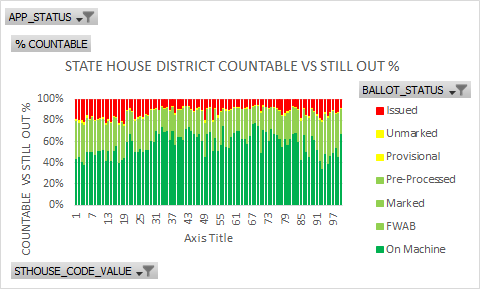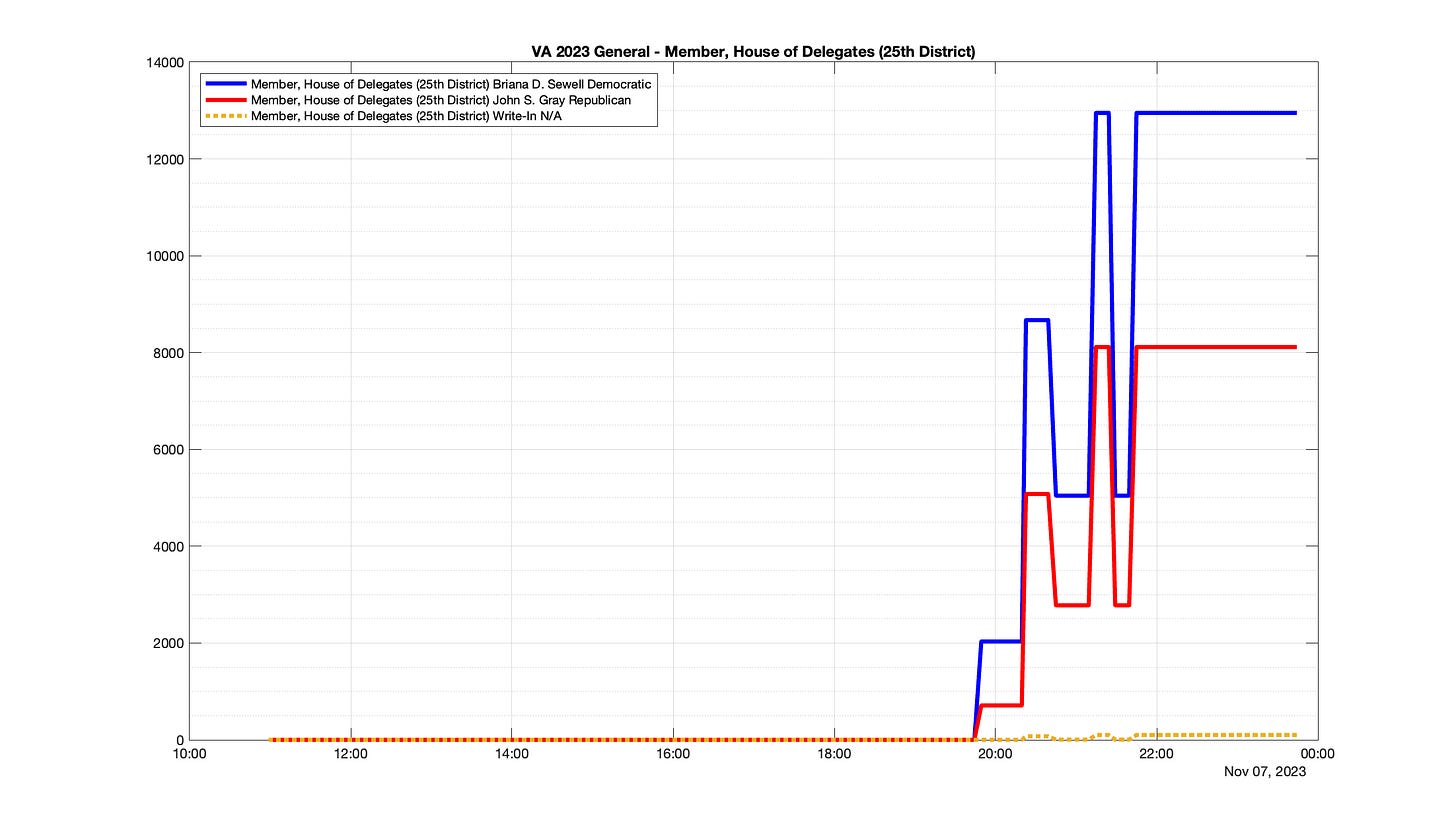VA Election: Fewer Military Votes
Virginia's 2023 General Election races have been called -- except for House District 82 due to absentee ballots yet counted. Plus, more on oscillating voter data, and military ballot failure rates.
Virginia’s General Election 2023 races to determine General Assembly and local races have been called — except for House District 82.
Although the results won’t change the Democrats’ majority in the Senate or the House of Delegates, which it controls by 51 seats, a Republican win in the district would make the difference much closer with 49 Delegate seats for Republicans.
As of Friday, the Republican incumbent Kim Taylor was hanging on to her lead with 14,201 votes, a 266-vote difference over Kimberly Pope Adams, her Democrat challenger.
Still to be processed are some 838 absentee ballots, per the Dept. of Elections’ Daily Absentee List (DAL) as of Friday, Nov. 10th.
According to Virginia’s Dept. of Elections, all absentee ballots ballot must be postmarked on or before election day and received by the voter’s general registrar’s office by noon on the third day after an election.
Due to the federal observance of Veteran’s Day on Friday, Nov. 10, the ballots are instead due by Monday, which corrects our prior post.
(All of the deadlines can be downloaded here, which EPEC Team will be checking more carefully.)
According to the DAL, 128,098 absentee ballots are still in “issued” status, which means they are still out. Other calculations set the number at 128,325 absentee ballots still out. We will likely know more over the weekend.
So races have been called, but as we can see from EPEC Senior Analyst Rick Naigle, many districts still have some absentee ballots coming their way.
In this example, Naigle has sorted the House Districts with the largest percentiles of ballots still outstanding with red shading. The light green are in various “countable” states.
The same would be true for Senate District seats, as the red shading shows which races, although already called, still have ballots to be processed. They are unlikely to change the outcomes.
According to EPEC’s calculations of the Early Voting data, the Dept. of Elections processed 821,888 early voting ballots (in person and by mail), according to the Daily Absentee List (DAL).
Military Ballot Returns Continue to Fail at a High Rate
The early voting tallies show that 13,865 voters requested what is known as UOCAVA absentee ballots (military, overseas and temporary federal).
As of Friday, Nov. 10th, the DAL record shows 7237 absentee ballots had been tabulated, with 243 listed as “provisional” and “unmarked,” and 6230 showing as issued but not returned.
That works out to a failure rate of between 46.1% and 48% (depending on how some of the ballot statuses are counted).
According to Naigle, the record shows that 46.1% of all UOCAVA voters’ ballots were not tabulated, but 67.8% of UOCAVA By Mail - the ones who must rely on Absentee voting, were not tabulated.
The success rate of the general public’s absentee ballot rate ranges above 70%. For these military voters however, it’s much lower overall at about 52%.
On this federal observance of Veterans Day and the official Veterans Day holiday Saturday, it is a statistic to ponder and investigate as to why the military ballots are not being returned. EPEC will stay on the story.
About the Oscillating Voter Data, Part II
EPEC Team received some great feedback on our post about the oscillating raw voter data as it came into the Dept. of Elections output feed on election night Nov. 7th.
As we reported in our last issue:
EPEC’s monitoring of Dept. of Elections’ live voting feed on election night, the same feed that VPAP.org and other outlets use, has raised a few questions on how the initial reports of vote tallies are managed.
EPEC’s tech lead Jon Lareau logged all of the election night return files posted by the VA department of elections (“ELECT”) at five-minute increments on Election Day in order to plot the results over time as the numbers came in later that night.
The data is from this link on ELECT’s website: https://enr.elections.virginia.gov/results/public/api/elections/Virginia/2023-Nov-Gen/files/json
The data feed used a simple “wget” script to grab this file once every five minutes (approximately).
However, when time came to plot the results, EPEC found some data curves that defy explanation. Take, for example, the VA House of Delegates race in the 22nd District, which Lareau plotted straight from the Dept. of Elections feed
:
That’s quite a fluctuation. Here’s another example:
Your humble EPEC volunteers wanted to acknowledge that, in the rush to get the results from the precincts to the reporting localities and into the state to report out, mistakes can happen that are eventually corrected.
One of our readers in Prince William County provided excellent feedback about that process, which we share below:
The data that is reported to ELECT by PWC on election night is based on manual inputs by chief election officers into a TallyPoint (Demtech) App on an iPad. The data is read off of the scanner results tape by the chief officer. The V Dr., for the heart scanner, remains, locked and sealed in the scanner and locked in the crate for delivery the next day on the eighth to the warehouse.
On [Nov. 8th], the electoral board reviews every set of documentation from each precinct focused on verifying the data sent to ELECT. This is where errors are detected in data entry by the Chiefs, which general registrars then correct.
The small thumb drives and pollpad data are returned on election night.
The electoral board then begins documentation review of each precinct and completes the count verification of the [absentee ballot processing] CAP.
These are expected to be revised when the last balance arrives, which would be no later than Monday at noon due to the holiday.
Then, if it makes sense to the Office Of Elections, headquarters. They send them to ELECT.
EPEC Team appreciates the feedback, and explanations of the journey of Virginia’s votes from ballot, to scanners, and then through networks and a review system before they are reported, checked, canvassed, and certified.
As for the reasons for the ossiliating results which advanced then retreated on numbers, EPEC Team has sent queries to state officials about it.
In the meantime, we are monitoring the data.
That’s a wrap until the next report. Happy Veterans Day to all who have served. #







